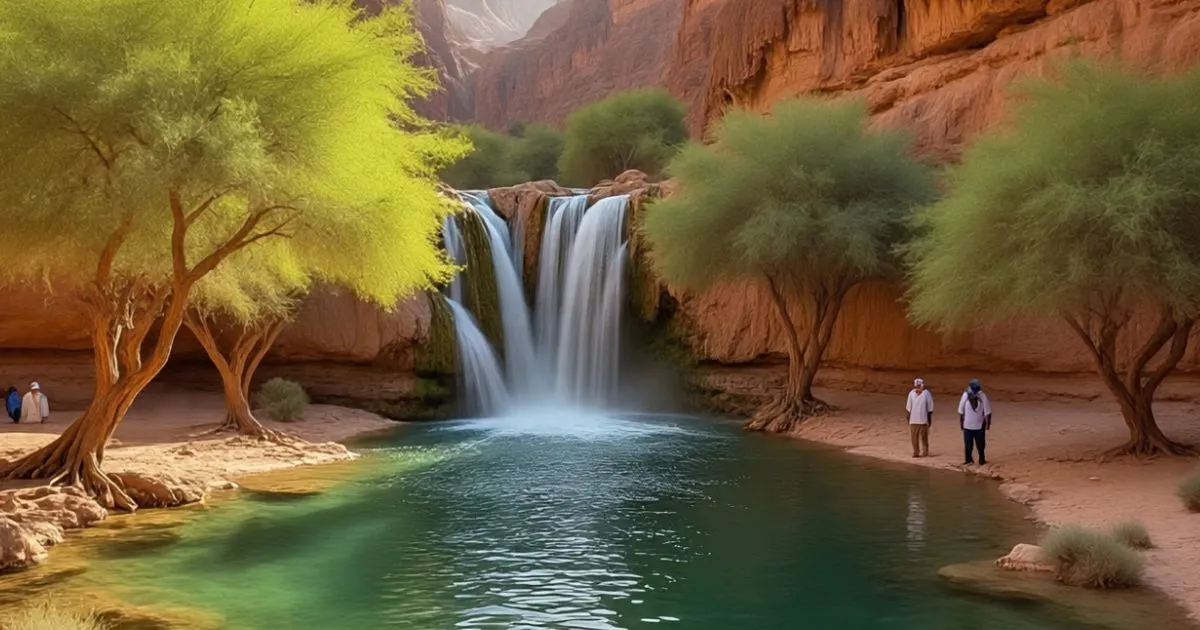Abu Daba Waterfalls Madinah’s Hidden Natural Oasis
Table of Contents
Abu Daba Waterfalls: Madinah’s Hidden Natural Oasis
For visitors to Madinah, the spiritual heart of Saudi Arabia, the city’s grand mosques and historical sites often take center stage. Yet, just beyond its bustling streets lies a hidden natural treasure—Abu Daba Waterfalls (شلالات أبو ضبع) in the serene Abyar Al-Mashi district. This striking cascade offers a rare glimpse of Saudi Arabia’s rugged beauty, where water tumbles over rocky cliffs, carving a lush escape amid the arid landscape.
Unlike the urban energy of Madinah, Abu Daba Waterfalls provide a tranquil retreat for hikers, photographers, and nature lovers. Whether you’re a pilgrim seeking a peaceful side trip or an adventurer eager to explore off-the-beaten-path wonders, this seasonal waterfall promises an unforgettable experience.
A Natural Masterpiece: The Landscape of Abu Daba
Nestled within rocky valleys, Abu Daba Waterfalls come alive after rainfall, transforming the typically dry terrain into a flowing spectacle. The water cascades over layered stone, creating small pools perfect for cooling off. Surrounding the falls, hardy shrubs and acacia trees dot the landscape, offering pockets of shade and a habitat for local wildlife.
The best time to visit is between November and March, when cooler temperatures and occasional rains rejuvenate the falls. During summer, the water may dwindle, but the dramatic rock formations and sweeping views remain impressive. Early mornings or late afternoons are ideal for avoiding the midday heat while capturing the golden glow on the cliffs.
Journey to the Falls: Getting There from Madinah
Located approximately 60–70 km southwest of Madinah, reaching Abu Daba Waterfalls requires a private vehicle, preferably a 4×4 due to uneven desert roads. The drive takes about 1.5 hours, passing through small villages and vast open landscapes.
Directions & GPS Coordinates:
- Head southwest on Route 15 toward Abyar Al-Mashi.
- Follow local signs or use GPS coordinates (approximately 23.8765° N, 39.4521° E—verify before travel).
- The final stretch may involve off-road driving; check conditions in advance.
Public transportation is unavailable, so renting a car or hiring a local driver familiar with the area is recommended. Some tour operators in Madinah also offer guided excursions.
Experiencing Abu Daba: Adventure & Serenity
Once you arrive, the real exploration begins. Here’s what you can enjoy:
1. Hiking & Exploration
The terrain around the waterfalls is rocky and uneven, making sturdy footwear essential. Short hikes along the wadi (valley) lead to different vantage points, with some paths requiring light scrambling.
2. Picnicking by the Water
Pack a light meal and enjoy a picnic near the falls. The sound of flowing water and the open sky create a peaceful atmosphere—just remember to carry out all trash.
3. Photography & Birdwatching
The contrast of water against desert stone makes for stunning photos, especially at sunrise or sunset. Bird enthusiasts may spot desert larks, falcons, or even migratory species near the water.
4. Safety Tips
- Watch your step—rocks can be slippery near the water.
- Beware of flash floods during rainy seasons; avoid narrow valleys if storms are forecasted.
- Stay hydrated—bring plenty of water, as there are no facilities nearby.
The Story Behind the Name: Abu Daba (Father of Hyenas)
The name “Abu Daba” (أبو ضبع) translates to “Father of Hyenas,” sparking curiosity about its origins. Local folklore suggests that the area was once a habitat for hyenas, though sightings today are rare. Another theory ties the name to the rugged, wild nature of the landscape itself—untamed and striking, much like the animal.
While no major historical events are linked to the falls, the region has long been traversed by Bedouin tribes, who valued its seasonal water sources. Their deep knowledge of the land’s rhythms allowed them to thrive in this harsh yet beautiful environment.
Practical Tips for Visitors
To make the most of your trip, keep these tips in mind:
✔ Best Time to Visit: Winter months (November–March), especially after rainfall.
✔ What to Bring:
- Plenty of water and snacks
- Sunscreen, hat, and sunglasses
- Sturdy hiking shoes
- Camera or smartphone for photos
✔ Leave No Trace: Preserve the natural beauty by carrying out all waste.
✔ Respect the Environment: Avoid disturbing wildlife or removing plants.
Conclusion: A Hidden Gem Worth Discovering
Abu Daba Waterfalls offer a rare chance to witness the raw, untouched beauty of Saudi Arabia’s wilderness. For those visiting Madinah, this natural escape provides a refreshing contrast to the city’s spiritual and historical sites. By visiting responsibly, you help ensure that this hidden oasis remains pristine for future explorers.
If you have extra time, consider combining your trip with visits to Mount Uhud or the Date Farms of Madinah for a well-rounded journey through nature and history.
So, pack your sense of adventure and set out for Abu Daba—where the desert’s hidden waters await.

